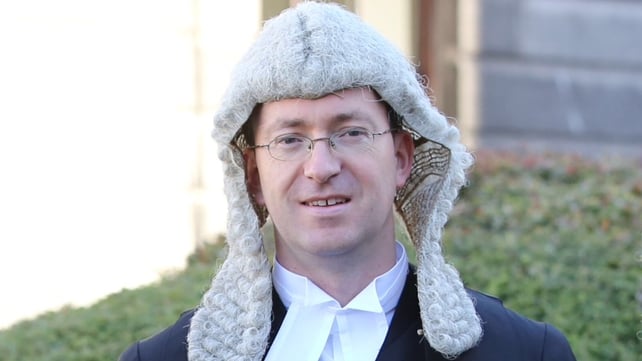New Justice reform pledged following Guerin 300 page report
INVESTIGATIONS INTO THE WHISTLE-BLOWER CLAIMS FINDS SHATTER AND GARDAÍ FAILED TO ADEQUATELY INVESTIGATE ALLEGATIONS.
Taoiseach Enda Kenny and Minister for Justice Frances Fitzgerald have said a “root and branch analysis” of the Irish justice system will be carried out as a result of the findings of an investigation by barrister Sean Guerin into allegations of corruption and malpractice in the force published today.
In his 300-page report on a dossier of claims handed in by Garda whistleblower Sgt. Maurice McCabe, Mr Guerin concludes that An Garda Síochána and former minister for justice Alan Shatter failed in their duties to properly investigate matters raised by Sgt McCabe.
THE REPORT VINDICATES SERGEANT MCCABE CLAIMS.
It says a comprehensive commission of investigation is “desirable in the public interest” to ensure “continuing confidence in the institution of An Garda Síochána and the criminal justice system”.
Responding to the report this evening, Taoiseach Enda Kenny said a root and branch analysis of the policy and practice of the administration of justice in Ireland is now needed. Mr Kenny said the Dail would debate the content of the Guerin report next week and he would welcome the contributions of all members.
“This is not just about politics, it is about getting it right for the people of our country-for the citizens, for the next generation, for everybody to have integrity, belief and faith in an Garda siochana, in the accountability, in the transparency in the way it is run,” he told reporters in Gort, Co Galway.
The newly appointed Minister for Justice Frances Fitzgerald said its findings reaffirm that “we must now enter a new era of policing in this country and that organisational reform and cultural change is essential.”
She said it raises “fundamental questions about the treatment and response to victims of crime which must be addressed as a matter of priority. The content and the findings are extremely grave.”
Interim Garda commissioner Noirín O’Sullivan said she was studying the report’s findings closely in conjunction with senior management “ to identify immediate actions that can be taken as part of our process of change that is currently underway”.
Sergeant Maurice McCabe tonight welcomed the findings of the Guerin report and said it had vindicated him.
“It is a good day after six years of fighting the system. Now I hope my family and I can move on.”
Sgt McCabe expressed his thanks to Fianna Fail leader Michael Martin for taking on his case and forwarding his file outlining his concerns over Garda conduct to Taoiseach Enda Kenny.
Sgt also mentioned that despite the findings of the Guerin report “I am still restricted from accessing Pulse”. He added that there had been no contact from anyone in senior Garda management after the report was published.
The findings?
Mr Guerin found that the “overall impression given by the internal Garda investigative process was that complaints or matters of concern were put through a process of filtration or distillation so that, by the end of the process, any matter of concern had been removed as a form of impurity, and only what was good was found to remain.”
Mr Guerin said the terms of reference for such a commission should include “definite matters of urgent public importance” such as:
- two incidents involving Jerry McGrath, who was later convicted of murdering Sylvia Roche-Kelly in Limerick 2007
- the investigation of sexual offences and child pornography offences by a priest with particular regard to the loss of a computer seized during the course of that investigation
Car sales in Ireland up 30.7% in first four months of this year
THE NUMBER OF NEW PRIVATE CARS ON IRISH ROADS ROSE 44.9% LAST MONTH.
The number of new private cars licensed for the first time rose by 30.7% in the year to the end of April, according to new figures from the Central Statistics Office.
The data show there were 51,123 new private cars licensed over the four-month period. The number of used imported cars licensed was 18,154, a rise of 21.8% compared to the same period a year earlier.
The number of new private cars on Irish roads rose 44.9% last month to 11,757, as against 8,113 cars for the same month a year earlier.
There were 1,502 new goods vehicles registered in April 2014, up 33% on April 2013.
Overall, the total number of all vehicles licensed in April 2014 was 20,593, up 32.3% compared with the 15,567 vehicles registered in the corresponding month last year.
Volkswagen was the most popular new private car to be licensed last month, followed by Nissan, Toyota and Ford.
Of the 11,757 new private cars licensed last month, 74.2% were diesel and 24.7%, petrol.
Seven Irish children killed by horror flesh eating bug over 2 years
Seven children have died from a lethal flesh eating bug that has been spreading in Ireland over the past two years.
The terrifying disease is now killing in higher numbers than meningitis and more than half of the 66 children who contracted the infection had to be treated in hospital intensive care units, with 70% needing surgery.
The invasive Group A Streptococcus infection (iGAS) hit three times as many girls as boys and 42% of those infected were aged two years or younger.
In some cases the disease was so aggressive that doctors had “little time for effective intervention”, a major European conference in Dublin has heard.
Two Irish doctors, Prof Karina Butler, consultant pediatrician at Our Lady’s Hospital in Crumlin, and Dr Juliette Lucey, from the infectious diseases departments at Our Lady’s and Temple Street Children’s Hospitals, described a “resurgence” of iGas in this country in the past two years.
They told the European Society of Paediatric Infectious Diseases in the National Conference Centre that 66 children were identified with confirmed or probable iGAS infection in the past two years.
Seven of these children died and half of the infected children were admitted to hospital intensive care units. They included 15 children with severe breathing difficulties, pneumonia and other serious lung and throat conditions.
Surgery was needed in 70% of cases to insert chest drains for complicated lung abscesses, remove infected skin around wounds or make incisions to relieve pressure.
COMPLICATION OF CHICKENPOX: Prof Butler said that one-in-five 20% of children developed iGas as a complication of chickenpox, but almost half (42%) had no identifiable risk factor.
She stressed the need for an effective vaccine and also said more vaccinations against chickenpox could prevent up to 20% of the iGas cases.
iGas is now killing more children than meningitis in children’s hospital across the country. It has a rate of more than 10% compared to 3-5% for meningitis in children and young people in this country.
“Much of the spotlight in recent years has been on diseases such as meningitis, whooping cough and other well-known infections in children,” she added.
“iGAS infections in children and young people are now on the rise in Ireland and most likely in other developed nations too.”
The infectious disease expert also said that while over 50% of the children needed to be treated in intensive care units, most of them had no identifiable risk for severe disease.
“Early identification and appropriate treatment and, ultimately GAS vaccination, are needed if outcomes are to improve,” she said.
The infection is difficult to diagnose but prompt diagnosis and treatment are essential and surgically removing infected tissue “may be life-saving”.
Increase in the number of Irish people facing heart failure


The number of people developing heart failure in Ireland is on the rise.
The Irish Heart Foundation says there has been an increase in the number of cases due to “an ageing population, obesity andpoor lifestyle“
Around 90,000 people in Ireland live with heart failure, but the group says thousands of people are at risk of missing fatal symptoms.
TODAY IS HEART FAILURE AWARENESS DAY.
Consultant cardiologist at St. Vincent’s Hospital in Dublin Professor Kenneth McDonald said: “Heart failure is a very prevalent problem in Ireland. There are approximately 100,000 people with this condition.”
“It occurs as a result of many other heart conditions such as heart attacks, for example, or long-standing high blood pressure.
“What people become aware of is increasing breathlessness with activity, or fatigue.”
Ireland reduces its greenhouse gas emissions by 11.5% in 2013
Electricity sector emissions fall 11.5% while food and drink industry gases rise 4%.
Greenhouse gas emissions by the electricity sector fell 11.5% in Ireland last year.
Ireland’s greenhouse gas emissons fell in 2013, largely because of an 11.5 % drop in emissions from the electricity sector, according to the Environmental Protection Agency (EPA).
It said this decrease may be partly due to extended shutdowns of units at the 1,200-megawatt Moneypoint coal-fired power station on the Shannon estuary coupled with the availability of renewables.
Large energy users covered by the EU Emissions Trading Scheme (ETS) cut their contribution by 7% compared to 2012, while cement industry emissions fell by 4% due to lower production.
Almost 100 major industrial installations in Ireland participate in the ETS. These include sites operating in the power generation, cement, lime, oil refining, food and drink, pharmaceuticals and electronics.
Bucking the trend, companies in the food and drink sector reported an overall increase of 4% in their emissions last year, reflecting strong growth in production in this export-led sector.
“Overall, recorded emissions show a welcome downward trend for 2013,” said EPA senior manager Dr Maria Martin. “However, this result does not detract from our awareness of the need to decouple carbon emissions from economic growth.
“We need radical structural reform of the EU Emissions Trading Scheme in order to ensure that the price of carbon will be at a level which incentivises real change in how we manage our energy requirements and reduce our greenhouse gas emissions”.
Earthly astronomers catch best-ever image of MASSIVE solar flare

Five telescopes catch X-class belch in exquisite detail.
A combined effort by four space telescopes and one Earth-bound observatory has successfully snapped the best images yet of a huge solar flare that erupted from the Sun’s surface.
The solar explosion occurred at 1:48pm EDT (5:48pm GMT) on March 29 and was an X-class flare, the largest type yet recorded by astronomers. The combined imaging from all the astronomical instruments involved has produced the most detailed pictures and video yet of the coronal mass ejection for future study.
NASA had three space-based telescopes focused on the area – the Interface Region Imaging Spectrograph, (IRIS), the Solar Dynamics Observatory (SDO), and the Reuven Ramaty High Energy Solar Spectroscopic Imager – with the Japanese Space Agency’s Hinode spacecraft and the National Solar Observatory’s Dunn Solar Telescope in New Mexico also sending in data.
Each of the five telescopes focused on different regions of the flare’s path out of the Sun’s environs. NASA’s SDO, for example, took images of the flare in relation to the entire star, whereas IRIS peered deep into the Sun’s lower atmosphere to image the first flare recorded by that orbital platform.
The whole effort was coordinated by the Dunn Solar Telescope, which identified the most likely spot for a big flare. It pinpointed the probable eruption point a day in advance of the flare, giving time for orbital platforms to focus in and, luckily, the eruption occurred at a good viewing time for the Dunn team to see it here on Earth.
“This is the most comprehensive data set ever collected by NASA’s Heliophysics Systems Observatory,” said Jonathan Cirtain, project scientist for Hinode at NASA’s Marshall Space Flight Center in Alabama.
“Some of the spacecraft observe the whole sun all the time, but three of the observatories had coordinated in advance to focus on a specific active region of the sun. We need at least a day to program in observation time and the target – so it was extremely fortunate that we caught this X-class flare.”
The size of the solar flare makes this an ideal event for larger study – X-class coronal mass ejections are the largest observed by man so far, although it’s theorized that a solar eruption in 1859 that burnt out telegraph systems across Europe and the US was an as-yet-unseen Z-class flare – at least 40 times as large as March’s display.
Were such a huge flare to occur today, the effects could be catastrophic. Satellites would be disabled and Earth-bound electric systems could take a major hammering and fail completely. A solar eruption 25 years ago knocked out power over large parts of Quebec and polar satellites suffered serious problems.
By coordinating observations, NASA and other space agencies are trying to learn as much as they can about the most violent phenomena in our Solar System. Doing so not only helps understand the Sun’s workings better, but could also allow the development of mitigation strategies,








No comments:
Post a Comment